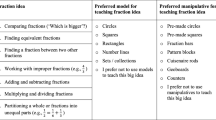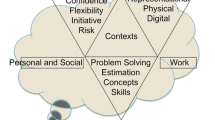Abstract
This study concerns pupils’ experience of unit and non-unit fractions of a discrete quantity during specially designed lessons. The aim was to explore pupils’ understanding of operations such as b/c of a in lessons where the teachers were aware of some pupils’ difficulties beforehand and what needed special attention. Five classes were involved in the study and 10 video-recorded lessons and written pre- and post-tests were analysed. Even though the lessons were designed for learning how to operate with both unit and non-unit fractions, we found that more pupils could solve items with unit fractions than with non-unit fractions. We found that few pupils in this study had difficulties with equal partitioning. Instead, it seemed difficult for some pupils to understand the role of the numerator and denominator and to differentiate between the amount of parts and the amount of objects in each part, and some pupils did not differentiate between the numbers of units and the amount of objects within a unit. This study identified some critical aspects that the pupils need to discern in order to learn how to operate with unit and non-unit fractions of a discrete quantity.








Similar content being viewed by others
Notes
Experience, seeing and understanding are used as synonyms.
References
Ball, D. L. (1993). Halves, pieces, and twoths: constructing and using represential contexts in teaching fractions. In T. P. Carpenter, E. Fennema, & T. A. Romberg (Eds.), Rational numbers: An integrating of research (pp. 157–195). Hillsdale,: Lawrence Erlbaum.
Behr, M. J., Harel, G., Post, T., & Lesh, R. (1992). Rational number, ratio, and proportion. In D. A. Grouws (Ed.), Handbook of research on mathematics teaching and learning (pp. 296–333). New York: Macmillan.
Behr, M. J., Harel, G., Post, T., & Lesh, R. (1993). Rational numbers: towards a symantic analysis - emphasis on the operator construct. In T. Carpenter, E. Fennema, & T. Romberg (Eds.), Rational numbers: An integration of research (pp. 13–47). Hillsdale: Lawrence Erlbaum.
Brizuela, B. (2005). Young children’s notations for fractions. Educational studies in Mathematics, 62(1), 281–305.
Bryman, A. (2004). Social research methods. United States: Oxford University Press.
Empson, S. B. (1999). Equal sharing and shared meaning: the development of fraction concepts in a first-grade classroom. Cognition and Instruction, 17(3), 283–342.
Empson, S. B. (2011). On the idea of learning trajectories: promises and pitfalls. The Mathematics Enthusiast, 8(3), 571–598.
Empson, S. B., & Levi, L. (2011). Extending children’s mathematics: Fractions and decimals. Portsmouth: Heinemann.
Gibson, J. J., & Gibson, E. J. (1955). Perceptual learning: differentiation –or enrichment? Psychological Review, 62(1), 32–41.
Hackenberg, A. J. (2007). Units coordination and the instruction of improper fractions: a revision of the splitting hypothesis. Journal of Mathematical Behavior, 26, 27–47.
Häggström, J. (2008). Teaching systems of linear equations in Sweden and China: What is made possible to learn? (Gothenburg studies in educational sciences 262). Göteborg Acta Universitatis Gothoburgensis.
Kerslake, D. (1986). Fractions. A report of the strategies and errors in secondary mathematics project. Windsor: Nfer-Nelson.
Kieren, T. E. (1993). Rational and fractional numbers: From quotient fields to recursive understanding. In T. P. Carpenter, E. Fennema, & T. A. Romberg (Eds.), Rational numbers: An integration of research. Hillsdale: Lawrence Earlbaum.
Kullberg, A. (2010). What is taught and what is learned. Professional insights gained and shared by teachers of mathematics (Gothenburg studies in educational sciences 293). Göteborg: Acta Universitatis Gothoburgensis.
Kullberg, A., Watson, A., & Mason, J. (2009). Variation within, and covariation between, representations. In M. Tzekaki, M. Kaldrimidou, & C. Sakonidis (Eds.), Proceedings of the 33rd Conference of the International Group for the Psychology of Mathematics Education (Vol. 3, pp. 433–440). Thessaloniki: PME.
Lamon, S. J. (1996). The development of unitizing: its role in children’s partitioning strategies. Journal for Research in Mathematics Education, 27, 170–193.
Lewis, C., Perry, R., & Murata, A. (2006). How should research contribute to instructional improvement? The case of lesson study. Educational Researcher, 35(3), 3–14.
Lo, M. L. (2012). Variation theory and the improvement of teaching (Gothenburg studies in educational sciences 323). Gothenburg: Acta Universitatis Gothoburgensis.
Mack, N. K. (1993). Learning rational numbers with understanding: The case of informal knowledge. In T. P. Carpenter, E. Fennema, & T. A. Romberg (Eds.), Rational numbers: An integration of research. Hillsdale: Lawrence Earlbaum.
Marton, F. (1981). Phenomenography - describing conceptions of the world around us. Instructional Science, 10(2), 177–200.
Marton, F., & Booth, S. (1997). Learning and awareness. Mahwah: Lawrence Erlbaum.
Marton, F., & Neuman, D. (1996). Phenomenography and children’s experience of division. In P. L. Steffe, P. Nesher, P. Cobb, G. A. Goldin, & B. Greer (Eds.), Theories of mathematical learning. Mahwah: Lawrence Erlbaum.
Marton, F., & Pang, M. F. (2006). On some necessary conditions of learning. The Journal of the Learning Sciences, 15(2), 193–220.
Marton, F., & Tsui, A. B. (2004). Classroom discourse and the space of learning. Mahwah: Erlbaum.
Marton, F., Runesson, U., & Tsui, A. B. (2004). The space of learning. In F. Marton & A. B. Tsui (Eds.), Classroom discourse and the space of learning (pp. 3–40). Mahwah: Erlbaum.
Mason, J. (2004). Researching your own practice. The discipline of noticing. London: Routledge Falmer.
Mason, J. (2010). Noticing. Roots and branches. In M. Gamoran Sherin, V. R. Jacobs, & R. A. Philipp (Eds.), Mathematics teachers noticing: Seeing through teachers’ eyes. New york: Routlege.
Morris, A. K., & Hiebert, J. (2011). Creating shared instructional products: an alternative approach to improving teaching. Educational Researcher, 40(1), 5–14.
Olive, J. (2011). Fractions on a dynamic number line. In B. Ubuz (Ed.), Proceedings of the 35th Conference of the International Group for the Psychology of Mathematics Education (Vol. 3, pp. 289–296). Ankara: PME.
Olive, J., & Vomvoridi, E. (2006). Making sense of instruction on fractions when students lacks necessary fractional schemes: the case of Tim. Journal of Mathematical Behavior, 25(1), 18–45.
Pang, M. F. (2010). Boosting financial literacy: benefits from learning study. Instructional Science, 38(6), 659–677.
Petit, M. M., Laird, R. E., & Marsden, E. L. (2010). A focus on fractions. Bringing research to the classroom. New York: Routhledge.
Pitkethly, A., & Hunting, R. (1996). A review of recent research in the area of initial fraction concepts. Educational Studies in Mathematics, 30(1), 5–38.
Runesson, U. (1999). Variationens pedagogik. Skilda sätt att behandla ett matematiskt innehåll [The pedagogy of variation. Different ways of handling the same topic; in Swedish]. Göteborg: Acta Universitatis Gothoburgensis.
Runesson, U., & Mok, I. (2005). The teaching of fractions: a comperative study of a Swedish and a Hong Kong classroom. Nordic Studies in Mathematics Education, 8(2), 1–15.
Steffe, L. P. (2004). On construction of learning trajectories of children: the case of commensurate fractions. Mathematical Thinking and Learning, 6(2), 129–162.
Steffe, L. P., & Olive, J. (2010). Children’s fractional knowledge. New York: Springer.
Thompson, P. W., & Saldanha, L. A. (2003). Fractions and multiplicative reasoning. In J. Kilpatrick, G. Martin, & D. Schifter (Eds.), A research companion to the principles and standards for school mathematics (pp. 95–114). Reston: National Council of Teachers of Mathematics.
Tzur, R. (2004). Teacher and students’ joint production of a reversible fraction conception. Journal of Mathematical Behavior, 23(1), 93–114.
Watanabe, T. (1995). Coordination of units and understanding of simple fractions: case studies. Mathematics Education Research Journal, 7(2), 160–175.
Wilkins, J. L. M., & Norton, A. (2011). The splitting loope. Journal for Research in Mathematics Education, 42(4), 386–416.
Acknowledgments
The research reported in this article was supported financially by a grant from the Swedish National Research Council. We would like to thank Joanne Lobato, Cecilia Kilhamn and Marj Horne for their thoughtful comments on drafts of this paper. We especially thank the anonymous reviewers whose feedback contributed to a stronger article.
Author information
Authors and Affiliations
Corresponding author
Rights and permissions
About this article
Cite this article
Kullberg, A., Runesson, U. Learning about the numerator and denominator in teacher-designed lessons. Math Ed Res J 25, 547–567 (2013). https://doi.org/10.1007/s13394-013-0080-9
Received:
Accepted:
Published:
Issue Date:
DOI: https://doi.org/10.1007/s13394-013-0080-9




